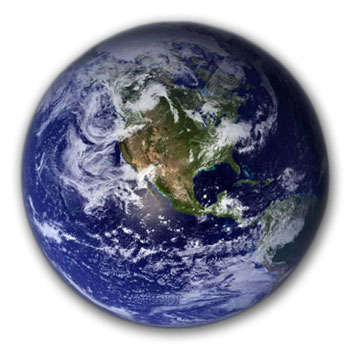Oceans are 71% of Earth’s Surface, but more than 99% of Biosphere
 If asked how much of our planet is ocean, most educated people will give a correct approximate of something like the “two thirds.” A more accurate answer would be about 71% of the planet’s surface area.
If asked how much of our planet is ocean, most educated people will give a correct approximate of something like the “two thirds.” A more accurate answer would be about 71% of the planet’s surface area.
That two dimensional view misses the important perspective, the three dimensional volume that supports life, known as the biosphere. Then the ocean percentage zooms to an amazing 99% or more. Some estimates go as high as 99.97%.
This is not some gimmick, or barroom statistical challenge. It points out an important and usually overlooked concept.
On land, the biosphere extends from a few feet down in the soil, as deep as roots, worms, and microbes live; up to the height of the tree canopy, and the ambiguous altitude for birds. All together a modest depth of hundreds of feet, or perhaps a few thousand.
The oceans are another matter. All seawater contains life, so the marine biosphere includes every drop of water. Starting with that 71% of the SURFACE AREA, we need to consider the depth, or height to grasp the volume. At the deepest point, the oceans are almost 7 miles deep. (You may recall that James Cameron — producer of Titanic, Avatar, etc. — recently ventured down to the deepest point; the third person ever to go there.)
Ocean depths vary greatly. The global average is approximately 12,000 feet, a little over 2 miles (3 km). Multiplying the surface area by those depths of ocean versus terrestrial yields that figure of 99%.
It seems irrelevant to us land based creatures until you consider that:
- The biggest biomass on the planet is composed of the tiniest plants, the phytoplankton. Easy to overlook, these tiny, tiny bits of algae produce about half the oxygen, upon which we depend.
- Phytoplankton are also the base of the marine food chain. Every animal in the sea eats plankton, either indirectly up the food chain, and directly as in the case of the big animals — the blue whale, the humpback whale, and the whale shark, all of which strain enormous quantities of water to nourish themselves on the plankton. It is the most efficient food energy system on the planet.
- As the oceans warm, and as the carbon dioxide in the atmosphere dissolves in the sea, making it more acid (technically, less alkaline), the ocean food web is changing, and quickly. That will likely have far reaching effects from the coral reefs, to the fish we eat, to the shellfish — which are showing the earliest signs of impact from the reduced pH.
A lot is at stake with the changing ocean. To realize the significance, it is useful to realize that it does represent 99% of the biosphere. The oceans are changing. Changing temperatures and salinities will change ocean currents, which might include the gulf stream, the El Nino / La Nina oscillation in the Southern Pacific.
Few people realize the importance of the ocean. The fact that you are reading this, indicates you are one who does. Stay tuned as we examine the features of the changing sea.
